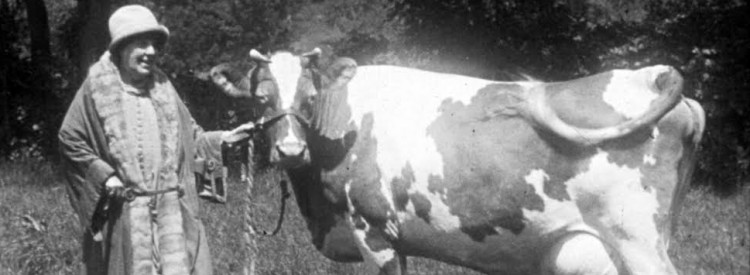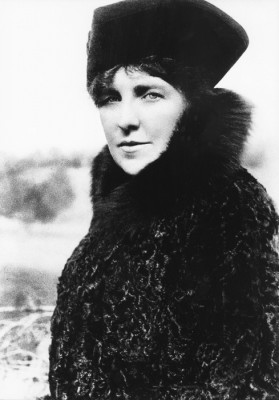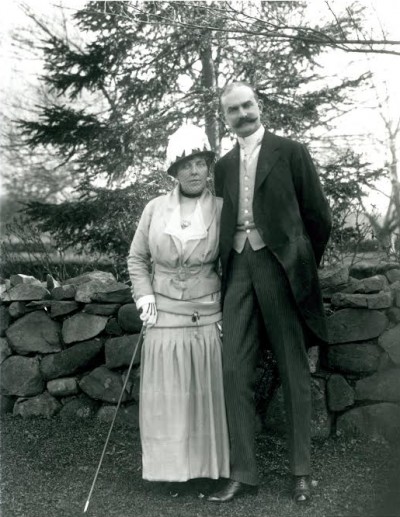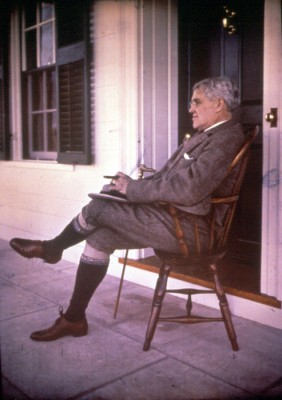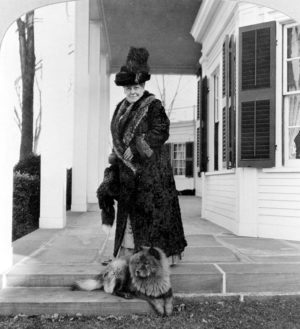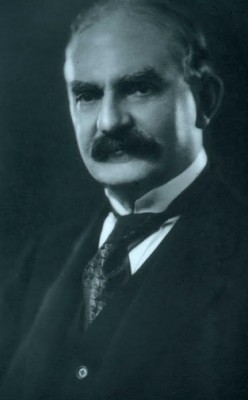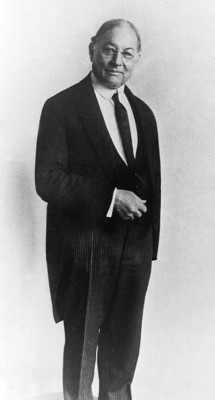 Theodate Pope Riddle
Theodate Pope Riddle
February 2, 1867- August 30, 1946
Hill-Stead’s story begins with founder Theodate Pope Riddle, an only child of privilege, who yearned to live on a farm in an era when women of her class were expected to focus on family and social prominence. Theodate was born in 1867, grew up in Cleveland, Ohio, and continued her education in the late 1880s at Miss Porter’s School in Farmington, Connecticut, then a finishing school. From an early age, she envisioned a future of living in the country, caring for orphaned children, and building a school. In addition to a career as an architect, Theodate was involved in social causes, had a profound interest in psychical research, and operated a successful farming enterprise. Her varied circle of friends were just as accomplished and forward thinking as she.
Unsinkable.
In May 1915, Theodate traveled to England to visit the British Society of Psychical Research. She was a passenger on the R.M.S. Lusitania when it was torpedoed by a German submarine. She survived, even after being pulled from the water and sent, unconscious, to a nearby morgue. One year later, at age 49, she married 51-year-old John Wallace Riddle, a diplomat, whom she had met 12 years earlier through Farmington friend and neighbor Anna Roosevelt Cowles (President Theodore Roosevelt’s sister). The Riddles traveled widely, and took an extensive tour in 1919 of China, Japan, and Korea. In 1914, Theodate had taken in a two-year-old orphan, Gordon Brockway, who died of polio in 1916. In 1917 and 1918, she took in two more orphaned boys, Donald Carson and Paul Martin, whom she raised as foster children.
An enduring legacy.
Theodate died in 1946. Her will stipulated that Hill-Stead become a museum as a memorial to her parents and “for the benefit and enjoyment of the public.” She called for the house and its contents to remain intact, not to be moved, lent or sold. Along with Hill-Stead, all but one of Theodate’s buildings still stand today as an enduring testimony to one of this country’s earliest important women architects.
Significant achievements
- 1901: Completes Hill-Stead
- 1906-1909: Designs and constructs Westover School, Middlebury, CT
- 1911-1914: Builds three houses for Hill-Stead workers at 179, 181 and 183 Garden Street, Farmington
- ca. 1913: Constructs Dormer House for Mrs. Charles Gates, Locust Valley, Long Island, New York (destroyed by fire, Feb. 2014)
- 1914-1915: Constructs Hop Brook School, Naugatuck, CT
- 1916: Licensed as architect in New York
- 1918: Accepted into the American Institute of Architects
- 1920-1922: Reconstructs Theodore Roosevelt’s birthplace, New York City
- 1921: Begins construction of Avon Old Farms School, Avon, CT
- 1927: Avon Old Farms School opens
- 1933: Licensed as Connecticut’s sixth woman architect
 Alfred Pope
Alfred Pope
July 4, 1842-August 5, 1913
“…in business management I have held to the doing and results, rather than to the anticipation through estimates…”
– Alfred A. Pope, December 1900
As an art collector, Alfred Pope’s interest in Impressionist paintings – their immediacy and boldness – made him part of a select group of connoisseurs at the turn of the 20th century. He was among the first American collectors of Impressionism, a passion he shared with Louisine and H.O. Havemeyer of New York, the Potter Palmers of Chicago, and his good friend Harris Whittemore of Naugatuck, CT. Favoring quality over quantity, he took home the best works of art, not the most. Today, Hill-Stead houses his Impressionist collection, including singular examples by Manet, Monet and Degas. Pope’s collection at Hill-Stead is unique among these earliest collectors in that it remains intact in its original domestic setting.
Business
Keenly entrepreneurial and opportunistic, Alfred Pope epitomized the self-made man. He married Ada Brooks, his childhood sweetheart, in 1866, and worked alongside his father and brothers in the family woolen business. In 1869, he bought into the newly formed Cleveland Malleable Iron Company, and within 10 years, at the age of 37, rose to the rank of president. The firm prospered, and became the National Malleable Castings Company in 1891. Pope had “arrived,” and built a Queen-Anne Style house on Euclid Avenue, one of Cleveland’s most fashionable districts. After 32 years in industry, Pope and his wife “retired” to Farmington, Connecticut, where their only child, Theodate, had already been living after her tenure at Miss Porter’s School. Though involved in the iron business until his death in 1913, Alfred adopted a slower pace of life in Farmington, indulging his interest in favorite pastimes such as golf.
Artistic Pursuits
Pope’s interest in French Impressionist art was kindled in 1888-1889 when he took Ada and Theodate on a European Grand Tour. In addition to visiting such museums as the Louvre and the Luxembourg Palace in Paris, the Popes visited commercial Parisian art galleries, among them Paul Durand-Ruel’s gallery, the best known and influential of its time. There, Pope’s Impressionists education began.
Pope purchased his first Impressionist painting, Monet’s View of Cap d’Antibes, in 1889, during a trip to the continent. He returned home with three paintings by Monet, including Grainstacks, White Frost Effect. In 1894, during a four-month sojourn in Europe, he acquired Monet’s Fishing Boats at Sea and Manet’s The Guitar Player. During this trip, he also bought his first painting by the American expatriate artist James McNeill Whistler. In addition to collecting in Europe, Pope acquired Impressionist pieces from dealers in New York City, where he and Ada maintained a residence at the Windsor Hotel (Fifth Avenue between 46th & 47th Streets).
When Pope found himself in possession of a work that did not meet his standards or, perhaps, did not fit with the other works in his collection, he was quick to exchange it. He was both a rugged individualist, relying on his own judgment, and like most collectors, influenced by the trends of his time. A select cadre of friends and family helped guide his choices, including brother-in-law and artist Edward (Ned) Brooks, family friend and artist Clinton Peters, and James McNeill Whistler, with whom Alfred Pope maintained a friendship for nearly ten years. None of these acquaintances, however, assumed the role of official advisor.
Today, the Alfred Atmore Pope Collection is a testament to a man who developed a personal aesthetic worthy of a scholar. As one of the earliest Americans to collect Impressionist art, Pope did not rely on established academic conventions, but trusted instead his eye for the groundbreaking and the forward-looking. His business acumen gave him a sense of the practical: the relatively small size of his collection reflects his wish to own no more paintings than could be comfortably displayed and enjoyed throughout the house.
 Ada Brooks Pope
Ada Brooks Pope
March 31, 1844-May 6, 1920
“[Hill-Stead ]…seems to be running riot while we are away…I do not like to be kept in the dark as to my affairs at home.”
– Ada Pope in a letter to her daughter, 1904
Ada Brooks, born and raised in Salem, Ohio, was the third of eight children. By 1862, at age eighteen, she had lost both of her parents. She remained very close to her siblings throughout their lives, often joining them in Vermont where their parents had been born. Following her marriage to Alfred Pope in 1866, she made directing the Pope household her life’s work, as was the custom of 19th -century women of privilege. She accomplished this task with skill and grace, enjoying life on fashionable Euclid Avenue in Cleveland. The Popes also kept an apartment in New York City. Being well-established in the societies of Cleveland and New York, they reacted coolly to their daughter Theodate’s urging to move to rural Farmington, Connecticut to become landed gentry.
Ada, however, soon took to country living. It was she who acquired many of the furnishings for Hill-Stead and created its stylish yet comfortable environment. Much of what we know about daily life at Hill-Stead derives from her avid letter writing and her fastidious keeping of accounts. When Alfred died in 1913, Ada never fully recovered. In her later years she found it difficult to spend long winters at Hill-Stead and instead joined her siblings in California.
 John Wallace Riddle
John Wallace Riddle
July 12, 1864-December 8, 1941
“[John] certainly is of sufficient maturity to ‘know his own mind,’ and while…it seems to me as a rule inadvisable for a very poor man to marry a very rich woman, it often works entirely well.”
– Charles Flandrau, Riddle’s half-brother, to a relative, January, 1916
John Wallace Riddle was born in Philadelphia; his father died before his birth. When John was seven, his mother married Judge Charles Flandrau of St. Paul, Minnesota, a widower with two daughters. The couple had two more sons together. Although John funded his own education from a small inheritance, his step-father’s political connections helped advance his diplomatic career. After graduating from Harvard in 1886, John attended Columbia Law School and then the École des Sciences Politiques in Paris. He became a skilled linguist, fluent in six languages. His diplomatic posts included Turkey, Egypt, Romania, Russia, and Argentina.
John met Theodate in 1905 through mutual friend Anna Roosevelt Cowles, sister of Theodore Roosevelt. They married in 1916. Because of John’s height, Theodate called him “Totem,” while he called her his “Dearest of Geniuses.” John was an avid bridge player and a member of several social clubs in New York, Washington, DC, Philadelphia, St. Paul, Minnesota, and Paris.
 Earnest Bohlen
Earnest Bohlen
December 22, 1853 -December 11, 1943
“His association with the family was always—shall I say, ‘relaxed reserve.’ Everybody loved him dearly.”
– Donald Carson, Theodate Pope Riddle’s foster son, remembering Earnest, 1996
Earnest was born on a plantation near Montgomery, Alabama. His African-American mother was a seamstress. His father, a white overseer, was killed in the Civil War. When Earnest was in his late teens, his mother sent him North to find work. Earnest began working for the Popes as their butler around 1885 and remained with the family for nearly sixty years, until his death at age 90 in 1943. He managed domestic affairs, oversaw the household staff, and greeted and tended to the needs of the family’s many guests; he even accompanied the family on their European Grand Tour to tend to their personal needs while abroad. When Theodate became engaged to marry John Wallace Riddle in 1916, Earnest was among the first people in whom she confided. As a further sign of her esteem for him, she had him buried in the family plot in Farmington’s Riverside Cemetery.
For Further Reading
- Alfred Pope: An Evolution of Ingenuity, Hill-Stead Museum, 2022
- Katz, Sandra L. Dearest of Geniuses, A Life of Theodate Pope Riddle. Windsor, CT: Tide- Mark Press, 2003. www.tide-mark.com.
- O’Gorman, James F., ed. Hill-Stead, The Country Place of Theodate Pope Riddle. New York, NY: Princeton Architectural Press, 2010
If you are interested in purchasing any of these publications you can stop by the Museum Shop or contact Elena Hall (halle@hillstead.org or by phone at 860-677-4787 ex.112).
